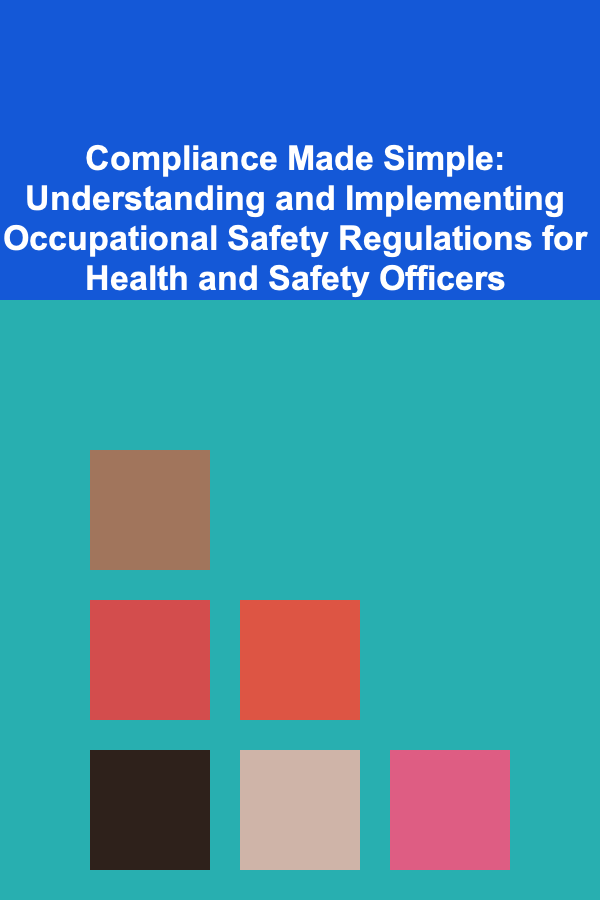
How to Maintain an Organized Workspace While Working from Home
ebook include PDF & Audio bundle (Micro Guide)
$12.99$8.99
Limited Time Offer! Order within the next:

The shift to remote work has transformed how we approach our daily routines, with many individuals finding themselves navigating the challenges of working from home. While the flexibility and comfort of working in a personal space can be appealing, it also presents unique difficulties---chief among them being organization. An organized workspace is essential for productivity, mental clarity, and overall well-being. This article delves into effective strategies for creating and maintaining an organized workspace while working from home, ensuring that you remain focused, efficient, and content in your professional endeavors.
Why an Organized Workspace Matters
1. Enhances Productivity
Research indicates that cluttered environments can impede focus and productivity. An organized workspace helps streamline tasks and allows you to find what you need quickly, enabling you to concentrate on your work without distractions.
2. Reduces Stress
A chaotic or disorganized environment can contribute to feelings of overwhelm and stress. An orderly workspace fosters a sense of calm and control, promoting better mental health and reducing anxiety.
3. Encourages Professionalism
Maintaining an organized workspace reflects professionalism, especially during video conferences or virtual meetings. An uncluttered background creates a more positive impression among colleagues and clients.
4. Promotes Creativity
A tidy environment can stimulate creativity by providing a clear, distraction-free space where ideas can flow freely. When everything has its designated place, it allows for enhanced cognitive functioning.
5. Supports Work-Life Balance
Establishing an organized workspace contributes to a clearer boundary between work and personal life, essential for maintaining a healthy work-life balance, particularly in a remote setting.
Assessing Your Current Workspace
Before implementing organizational strategies, it's crucial to evaluate your current workspace. Here are some steps to consider:
1. Identify Challenges
Take note of specific challenges you're facing. Are there too many items on your desk? Is your digital space chaotic? Understanding these issues will help you focus on areas needing improvement.
2. Evaluate Space and Layout
Consider the size and layout of your workspace. Is it functional? Does it accommodate your workflow? Make adjustments as necessary to optimize the space for productivity.
3. Analyze Tools and Equipment
Review the tools and equipment you use daily. Are they organized effectively? Do you have the necessary technology for seamless communication and collaboration?
Step-by-Step Guide to Organizing Your Workspace
Step 1: Declutter Your Physical Space
a. Remove Unnecessary Items
Begin by emptying your workspace. Remove all items from your desk and categorize them into three groups:
- Keep: Items you use regularly.
- Donate/Discard: Items that are no longer useful.
- Storage: Items you don't need immediately but want to keep.
b. Clean Surfaces
Once cleared, clean all surfaces thoroughly. Dust, wipe down, and disinfect your workspace to create a fresh start.
c. Implement the "One In, One Out" Rule
To prevent clutter from accumulating again, adopt the "one in, one out" rule. For every new item you bring into your workspace, remove an old one.
Step 2: Organize Your Workstation
a. Designate Zones
Create specific zones for various activities within your workspace:
- Primary Work Area: The main area where you perform tasks.
- Reference Zone: A separate area for books, manuals, and resources you frequently consult.
- Supplies Zone: A dedicated space for office supplies, tools, and technology.
b. Use Storage Solutions
Invest in storage solutions that suit your needs:
- Desk Organizers: Keep pens, sticky notes, and other small items neatly arranged.
- Shelving Units: Utilize vertical space for books and files.
- Drawer Dividers: Separate items within drawers for easy access and visibility.
Step 3: Optimize Digital Organization
a. Tidy Up Your Desktop
A cluttered digital desktop can be as distracting as a messy physical workspace. Take time to:
- Organize files into folders based on projects or categories.
- Remove unnecessary icons and applications.
- Use cloud storage for easy access and backup.
b. Streamline Email Management
An overflowing inbox can lead to chaos:
- Create folders and labels for sorting incoming emails.
- Set aside time each day for email management.
- Unsubscribe from newsletters or notifications that are no longer relevant.
Step 4: Establish a Routine
a. Create a Daily Schedule
Set a consistent schedule that includes dedicated work hours, breaks, and personal time. Stick to this routine to maintain structure throughout your day.
b. Prioritize Tasks
Utilize task management tools like to-do lists or project management software (e.g., Trello, Asana) to prioritize tasks, set deadlines, and track progress.
Step 5: Customize Your Environment
a. Personalize Your Workspace
Incorporate elements that make your workspace comfortable and inspiring:
- Decorative Elements: Add plants, photos, or artwork to enhance the ambiance.
- Comfort Items: Use ergonomic furniture, supportive cushions, or a standing desk to ensure physical comfort.
b. Control Lighting
Ensure adequate lighting in your workspace:
- Use natural light whenever possible; position your desk near windows.
- Invest in quality task lighting for evening work to reduce eye strain.
Step 6: Implement Decluttering Practices
a. Schedule Regular Cleanouts
Establish regular intervals for decluttering your workspace---weekly, bi-weekly, or monthly---to keep it organized over time.
b. Encourage Minimalism
Embrace minimalism by keeping only essential items within reach. This practice encourages a mindset focused on simplicity and efficiency.
Strategies for Maintaining Organization
1. Weekly Reviews
Set aside time each week to assess your workspace. Review your organization system, identify any emerging clutter, and adjust as needed.
2. Daily Tidying
At the end of each workday, take a few minutes to tidy your workspace. Put away stray items, clear your desk, and prepare for the next day.
3. Collaborate with Others
If you share a workspace with family or roommates, communicate openly about organizational preferences. Collaborating ensures everyone is on the same page regarding cleanliness and order.
4. Use Technology Wisely
Leverage digital tools that support organization:
- Note-taking Apps: Use apps like Evernote or Microsoft OneNote to keep track of thoughts and meeting notes.
- Calendar Apps: Sync calendars across devices to manage appointments and deadlines efficiently.
- Collaboration Tools: Utilize platforms like Slack or Microsoft Teams to streamline communication with colleagues.
5. Set Boundaries
Establishing boundaries can help maintain your workspace integrity:
- Designate Work Hours: Communicate your work hours to household members to minimize interruptions.
- Limit Distractions: Create a do-not-disturb signal during intense work periods to enhance focus.
Addressing Common Challenges
1. Procrastination
Challenge: Procrastination may arise due to distractions at home.
Solution: Break tasks into smaller, manageable segments and set specific time limits for each segment using techniques like the Pomodoro Technique.
2. Family Interruptions
Challenge: Remote work can lead to frequent interruptions from family members.
Solution: Communicate your work schedule clearly and establish designated quiet times for uninterrupted focus.
3. Lack of Motivation
Challenge: Working from home can sometimes lead to diminished motivation.
Solution: Refresh your workspace periodically. A change in scenery or decor can boost enthusiasm and reinvigorate your work ethic.
4. Overwhelm from Dual Roles
Challenge: Balancing work responsibilities with home duties can feel overwhelming.
Solution: Set clear boundaries between work and personal life. Designate specific areas for work and relaxation to mentally separate the two roles.
Creating a Long-Term Plan
1. Reassess Periodically
Every few months, take time to reassess your workspace and organization methods. What's working? What isn't? Adjust your strategies accordingly.
2. Stay Informed
Read articles, watch videos, or join webinars on organizational strategies and productivity tips to gather new insights and inspiration.
3. Make It a Habit
Incorporate organization practices into your daily routine until they become second nature. The longer you maintain these habits, the easier they will become.
4. Celebrate Small Wins
Recognize and celebrate your achievements in maintaining an organized workspace. Whether it's completing a project or mastering a new organizational method, acknowledging your progress can boost morale.
Conclusion
Maintaining an organized workspace while working from home is not just about aesthetics; it plays a significant role in enhancing productivity, reducing stress, and fostering a sense of balance. By following the strategies outlined in this guide---from decluttering and organizing your physical space to optimizing your digital environment and establishing routines---you can create a workspace that supports your work-life balance and personal goals.
Making these changes may require effort and commitment, but the rewards---a more productive, less stressful work experience---are well worth it. Embrace the opportunities afforded by remote work, and take charge of your workspace to cultivate an environment that inspires success and well-being.

Compliance Made Simple: Understanding and Implementing Occupational Safety Regulations for Health and Safety Officers
Read More
How to Conduct a Home Security Assessment
Read More
How to Earn Passive Income by Selling Pre-trained Deep Learning Models
Read More
How to Organize a Spa-Themed Home Party for Relaxation
Read More
How to Sort and Store Seasonal Decor for Easy Access
Read More
Mastering Retail Management: Essential Skills for Managing People and Profits
Read MoreOther Products

Compliance Made Simple: Understanding and Implementing Occupational Safety Regulations for Health and Safety Officers
Read More
How to Conduct a Home Security Assessment
Read More
How to Earn Passive Income by Selling Pre-trained Deep Learning Models
Read More
How to Organize a Spa-Themed Home Party for Relaxation
Read More
How to Sort and Store Seasonal Decor for Easy Access
Read More